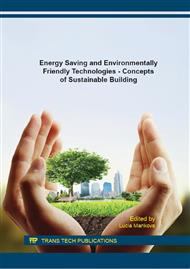p.331
p.339
p.347
p.355
p.363
p.371
p.379
p.387
p.395
Analysis of the Internal Insulation of Renovated Building
Abstract:
The trend in the new construction or renovation of buildings is based on reducing the energy demand of buildings. The required energy need for heating and provision of a satisfactory condition of the internal environment is determined by theoretical calculations. However, the fact that a building is energy efficient does not yet mean it is environmentally appropriate as well. Therefore, the environmental impact of building materials should also be assessed in their selection.The problem with restoring old buildings is to find the correct way how to restore the building while preserving its historical value. The paper presents an example of the reconstruction of the school building built in the year 1906. Reconstruction of the old building is a unique example of recovery. The modern and traditional techniques were used in the reconstruction. This is the first building in Slovakia, where is the front facade insulated with ecological materials (sheep wool, cork, cellulose, etc.) from the interior side and also utilization of alternative energy sources. Other parts of facade are insulated from the outside, with straw bales and wood fiber boards. Largely it has been preserving the original character of the building.Different types of wall structures are compared in theoretical evaluations. The criteria for the evaluation are the thermal resistance of construction (according to EU standards and norms), the weight of the wall and the environmental impact (according to OI3 methodology).
Info:
Periodical:
Pages:
363-370
Citation:
Online since:
January 2016
Authors:
Price:
Сopyright:
© 2016 Trans Tech Publications Ltd. All Rights Reserved
Share:
Citation:


